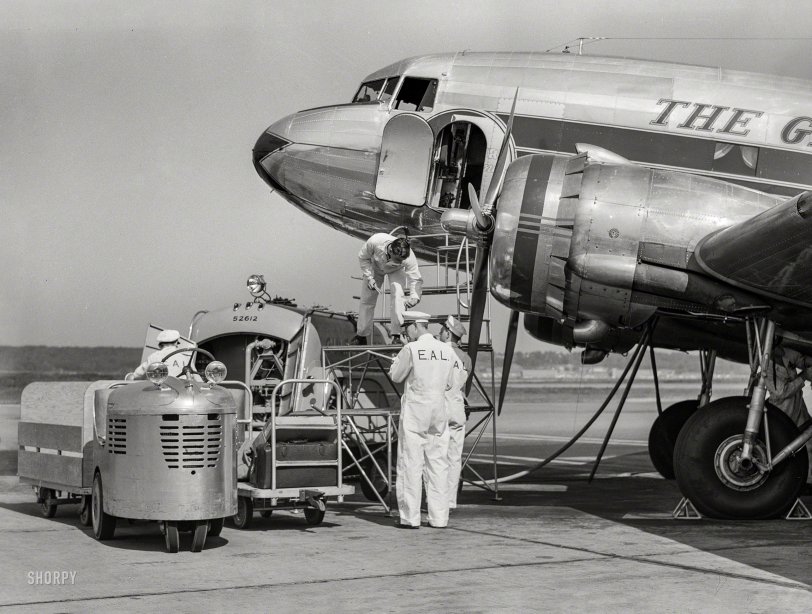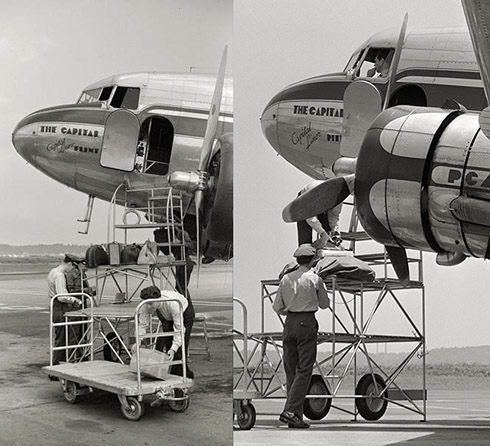


Framed or unframed, desk size to sofa size, printed by us in Arizona and Alabama since 2007. Explore now.
Shorpy is funded by you. Patreon contributors get an ad-free experience.
Learn more.

- Baldwin 62303
- Baldwin VO-1000
- Cold
- No expense spared
- Tough Guys
- Lost in Toyland
- And without gloves
- If I were a blindfolded time traveler
- Smoke Consumer Also Cooks
- Oh that stove!
- Possibly still there?
- What?!?
- $100 Reward
- Freeze Frame
- Texas Flyer wanted
- Just a Year Too Soon
- WWII -- Replacing men with women at the railroad crossing.
- Yes, Icing
- You kids drive me nuts!
- NOT An Easy Job
- I wonder
- Just add window boxes
- Icing Platform?
- Indiana Harbor Belt abides
- Freezing haze
- Corrections (for those who care)
- C&NW at Nelson
- Fallen Flags
- A dangerous job made worse
- Water Stop
Print Emporium
Eastern Air Lines: 1941

July 1941. "An airliner taking on baggage and fuel. Washington, D.C., municipal (National) airport." Medium format negative by Jack Delano. View full size.
Getting weighed by eye
The first time I flew on a commercial jet was in the mid-1980s, and I didn't have to step on a scale in the terminal. I do recall that the airline counter agent seemed to be doing quite a bit of typing to check all of us in, all while glancing back and forth from our tickets, to the computer terminal screen, and asking us things. Through at least the mid-1990s, I remember a similarly large amount of keyboard work at check-in. I also recall a stand-up comedian or two in that era making jokes about the agent writing a novel while you were standing there.
An acquaintance who worked as a programmer for American Airlines' SABRE system in the '80s told me that the agent was required to enter data on several different screens to get a passenger all the way checked in.
One of the items they were entering was their visual estimate of the passenger's weight! Apparently the jets being used by the time I flew (727, 737, and similar) weren't so sensitive that guessing wrong by 5 or 10 pounds per passenger would make a difference, but the software still did the math to make sure the total weight was within the limits, and that the left-right and fore-aft balances were at least close to where they should be.
I also found out later that the FAA, for some estimating purposes, used a standard weight of 170 pounds for adults in the 1980s, but later raised that to 180 pounds in the 1990s. Researching this just now, I found that they would also add about 5 pounds in the winter, to account for heavier clothing and coats.
I don't recall ever being asked to change seats for balance reasons on a "big" jet. I have flown on a turboprop, with about 30 total seats in a 2+1 layout. Most of us opted to sit on the two-seat side, fold up the middle armrest and stretch out. Before we took off, the flight attendant told us that the captain needed one person - it didn't matter who - to move over to the one-seat side. One guy moved and the flight proceeded normally.
Lovable Tug
The tow tractor (tug) at the left appears to be a Clark. So homely that it is lovable.
Missleading Title
If memory serves: the open door is for crew. Baggage is loaded further to the rear. The title obviously refers to all that is going on, not just what is shown.
[You're confusing the caption with the title (not to mention misspelling "misleading"). Delano's photos show baggage being loaded at the front of the plane. - Dave]

DC-3 cargo loading
In DC3s (as with any aircraft) the weight and balanced distribution of that weight is of vital importance. If you are old enough to have flown on one of those old airliners, you might remember being weighed at check in. Prior to departure, the aircraft had to be loaded so that the center of gravity was properly located.
There was no lower cargo deck on the DC-3. All baggage and cargo was stored between the cabin and the flight deck and aft of the cabin in the tail section.
Here is a manual from Quebecair from 1961
Lazy Susan
The far wheel (the one without the chocks) of the DC-3 appears to be resting on one of the short-lived turntables that were built into the apron at the newly opened D.C. airport.
When it was time to leave, the captain would apply the brake of the wheel that was on the turntable and gun the opposite engine, thereby "turning on a dime" (and theoretically reducing stress on the stationary/pivot landing gear and tire).
At least that's the way it was supposed to happen. They didn't last long, paved over like a lot of other ideas that didn't work out so well.
Polished natural metal glory!
It's good to see such a clear shot of an early variant of the DC-3 powered by Wright Cyclone engines.
She comes with lots of baggage
Is that really the baggage hold right behind the pilots?
I wouldn't want to be a cockpit crew of a plane that crashes with all that behind me. Also I would think that, plus the weight of the engines and wing assembly that far forward with very little weight in the tail would throw off the plane's balance.
Hopefully, that door forward leads down to a baggage hold in the plane's belly. If so, it looks like a very cumbersome way to load and unload baggage.
[Interesting that you mention crashing. - Dave]
























On Shorpy:
Today’s Top 5